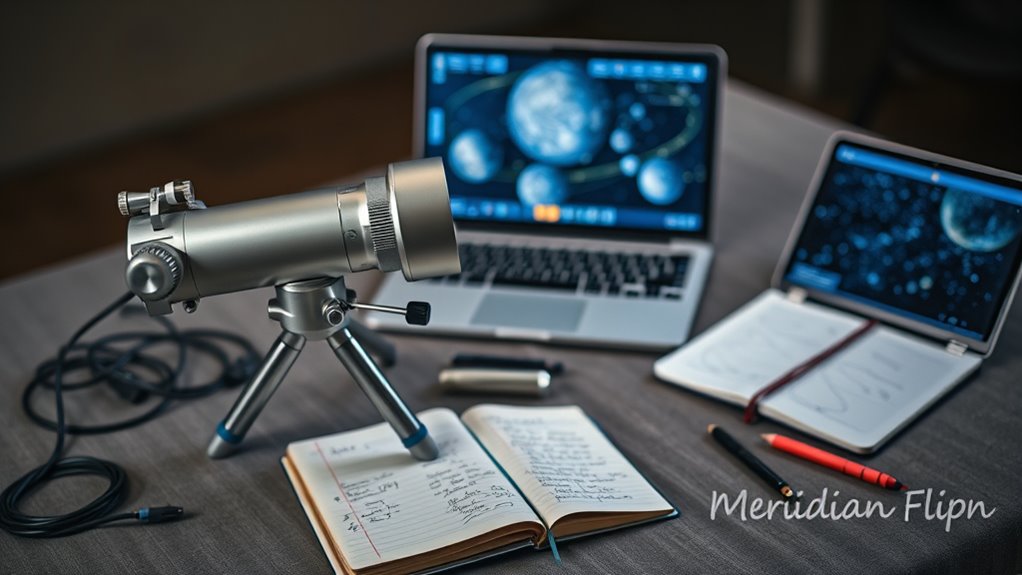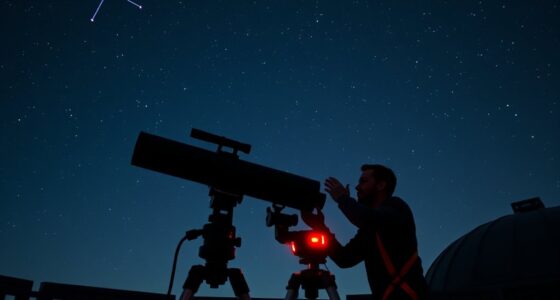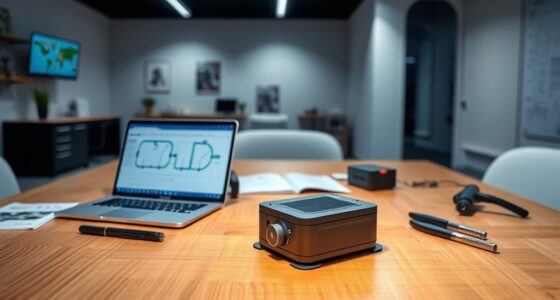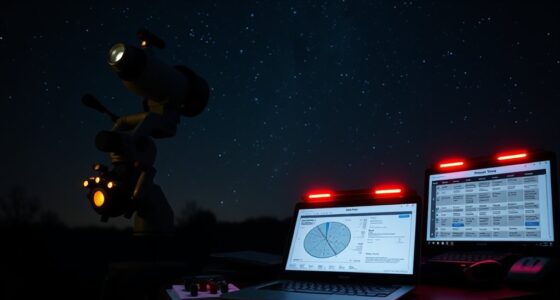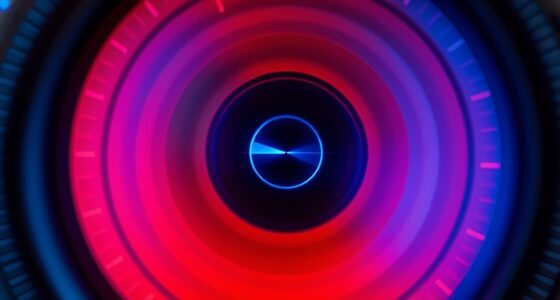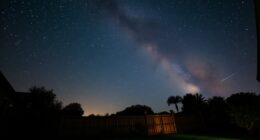To plan a smooth meridian flip, make sure you perform precise mount alignment and thorough calibration beforehand. Double-check your star alignment and camera settings to avoid surprises during the flip. Always test the process on a shorter session to identify any issues early. Don’t forget to verify that guiding and tracking are working perfectly before initiating the flip. Keep these essentials in mind, and you’ll set yourself up for success—more tips await as you continue.
Key Takeaways
- Do verify precise mount and polar alignment before imaging to ensure smooth tracking through the flip.
- Do calibrate your camera with darks, flats, and biases, and review settings prior to the meridian crossing.
- Do test the flip process on a short session to identify potential issues and fine-tune your setup.
- Don’t neglect to confirm software recognizes and is configured correctly for both mount and camera during the flip.
- Don’t skip rechecking calibration and focus after the flip to maintain image quality and accurate tracking.
Essential Preparations for a Smooth Meridian Flip
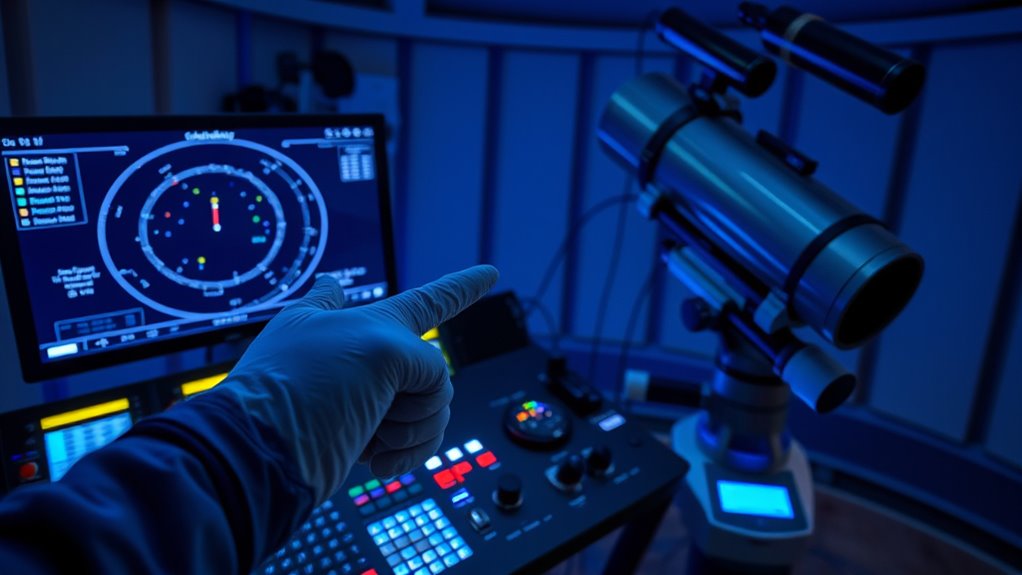
To guarantee a smooth meridian flip, you need to prepare your equipment and software in advance. Start by ensuring your mount alignment is precise, as any misalignment can cause issues during tracking and flipping. Double-check that your mount’s calibration is accurate, focusing on polar alignment and ensuring it tracks smoothly across the meridian. Next, calibrate your camera thoroughly to avoid misfocused images or exposure errors during the flip. Proper camera calibration, including darks, flats, and bias frames, helps maintain image quality. Confirm that your software recognizes your mount and camera correctly, and that all settings are optimized for the upcoming session. These preparations reduce surprises, streamline the flip process, and help you maintain consistent tracking before, during, and after the meridian flip.
Common Mistakes to Avoid During Meridian Flip Planning

One of the most common mistakes during meridian flip planning is neglecting to thoroughly verify your mount’s calibration and alignment beforehand. Misunderstanding mount alignment can lead to inaccurate tracking after the flip, causing star trails or blurred images. Additionally, neglecting camera settings can result in overexposure or undersampling during the transition. To avoid these issues: 1. Double-check your mount’s calibration and perform a star alignment. 2. Confirm that your mount’s tracking and guiding are functioning correctly. 3. Review and adjust camera settings before the meridian flip. 4. Test the flip process on a short session to identify potential problems. Ensuring proper mount calibration can significantly improve your tracking accuracy during the flip.
Frequently Asked Questions
How Do I Troubleshoot Failed Meridian Flips During Imaging Sessions?
When your meridian flip fails, first check your mount alignment, making certain it’s precise to prevent mechanical issues. Next, examine gear backlash, as excessive play can disrupt the flip. Tighten or adjust gears if needed, and verify that the mount’s tracking is stable. Using good calibration and periodic maintenance helps prevent these problems. Troubleshooting these areas often resolves flip failures and ensures smoother imaging sessions.
What Are the Best Software Tools for Automating Meridian Flip Planning?
You should consider using automation software like CCDWare’s CCD AutoPilot, NINA, or Sequence Generator Pro for flip scheduling. These tools streamline meridian flip planning by automating the entire process, reducing errors and saving you time. They allow precise flip scheduling, seamless integration with your mount and camera, and real-time adjustments. With these automation tools, you can focus more on capturing images and less on manual flip planning.
How Can I Optimize Meridian Flip Timing for Different Telescope Mounts?
To optimize meridian flip timing for different telescope mounts, you should focus on mount synchronization and flip accuracy. Regularly calibrate your mount’s polar alignment and guarantee precise synchronization with your guiding software. Use automation tools that account for mount-specific factors, such as backlash or gear slop. Planning flips just before the mount reaches the meridian minimizes risk, ensuring smooth, accurate flips and reducing downtime during your imaging session.
Are There Specific Mount Models That Handle Flips More Reliably?
Some mounts truly excel at flip reliability, making your night sky adventures smoother than ever. When choosing a mount, prioritize compatibility and reputation for handling flips seamlessly. Popular models like Paramount, GM6000, and AZEQ6 are known for their exceptional mount compatibility and flip reliability, reducing surprises during vital observation times. Investing in a well-designed mount ensures you won’t face frustrating failures, allowing you to enjoy the cosmos without unnecessary worries.
How Does Weather Impact Meridian Flip Scheduling and Planning?
Weather critically impacts your meridian flip scheduling and planning. Cloud cover can obscure your target, making it harder to determine ideal flip times, while high humidity can cause dew buildup, risking your equipment. To minimize issues, monitor local weather forecasts closely, plan flips during clear, dry conditions, and use dew prevention methods. Keeping an eye on cloud cover and humidity effects helps guarantee smoother, more dependable meridian flips.
Conclusion
Think of your meridian flip as steering a boat through calm waters—you want smooth sailing, not choppy waves. By preparing thoroughly and avoiding common pitfalls, you’ll navigate the flip with confidence and grace. Remember, a little planning keeps the journey steady, so you can focus on capturing stunning images rather than fixing surprises. With these basics in mind, you’ll sail seamlessly across the celestial ocean, making each session an adventure rather than a challenge.
